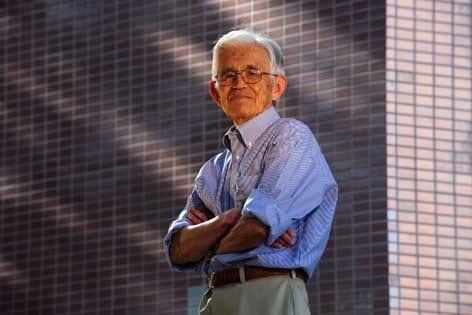Sharper images
Hindsight, unlike many people’s vision, is always 20/20. Laser eye surgery has become so common, it’s easy to forget that just three decades ago a promising new treatment was greeted with skepticism and even fear.
“When the ultrashort pulse laser came along, we were excited that it was a more controlled, delicate way of cutting eye membranes and tissue. But the concept met with resistance,” says UC Irvine ophthalmologist Dr. Roger Steinert. “Some critics said, ‘That’s just going to burn the retina.’ They didn’t understand that the mechanism of action was entirely different than the original lasers that worked by heating tissue, not cutting it.”
Steinert, chair of ophthalmology and director of UCI’s Gavin Herbert Eye Institute, is a pioneer in LASIK and excimer laser refractive surgery, developing techniques that have allowed millions to throw away their glasses and contact lenses — “crutches for the eyes,” he calls them. He was one of the first to demonstrate that lasers could safely sculpt eyes and cure common vision problems such as myopia and astigmatism.
“It’s a humbling moment when you take a human eye and do something to it for the first time,” he says.
In 1983, his laboratory group at the Massachusetts Institute of Technology became the second in the world to study excimer laser eye surgery. Steinert treated the first patients in 1987 and then conducted major Food & Drug Administration trials in the early 1990s. The FDA approved phototherapeutic and photorefractive keratectomy in 1995.
“But we didn’t stop there,” he says. “The field has changed dramatically since then.”
He’s continued to develop laser surgery techniques in a quest to help people see sharper images. For instance, he now uses iris recognition software combined with wavefront measurements (the sophisticated optical designs that astronomers use to sharpen telescope optics — the mechanism that optimized the Hubbel telescope, for example) for LASIK to precisely calculate and treat the distortions affecting the patient’s vision.
“We were pretty naive at the beginning. We were shaping the eye almost as though we were applying a contact lens,” he says. “Now we can line up the treatment perfectly based on the pattern of the iris, which is as unique as a fingerprint. The number of patients who see really well after the treatment is much higher. Negative effects, such as halos, are almost entirely gone.”
Steinert has received numerous awards for advancing eye care. He was recently named one of America’s top ophthalmologists by Becker’s ASC Review, and in 2008 he received refractive surgery’s highest honor, the Barraquer Award (video).
“Dr. Steinert is a fantastically gifted surgeon. He makes even the most difficult procedures look effortless,” says Dr. Sam Garg, assistant professor of ophthalmology and medical director of The Gavin Herbert Eye Institute, who began working with Steinert six years ago as a resident. “On top of that, he’s a great guy. A lot of people at his level let you know they carry that stature, but he doesn’t. He’s not intimidating. He’s very down-to-earth, and he’s supportive.”
Since joining UCI in 2004 after 23 years on the Harvard University faculty, Steinert has raised ophthalmology department’s profile, nearly tripling its size to 30 full-time and part-time faculty members. To meet the growing research and clinical care needs, The Gavin Herbert Eye Institute he directs broke ground April 7 on a 60,000-square-foot clinical and academic center.
His own sharp eye has helped Steinert excel in the field.
“Ophthalmologists are considered fairly obsessive about details,” he says. “We work in an environment that’s unforgiving. All of the surgery is done through a microscope. There’s no room for error.”
His real reward, he says, is seeing his patients no longer need those eye “crutches.”
“One of the nicest things about being an ophthalmologist is that most of the time we’re able to help people,” he says. “My favorite days are when the post-op patients come into the clinic. It’s the ‘wow’ factor — to have someone who has needed glasses or contacts have perfect vision without them. You see these big smiles on their faces.” And you see them clearly.
Originally published in ZotZine Vol. 3, Iss. 7


